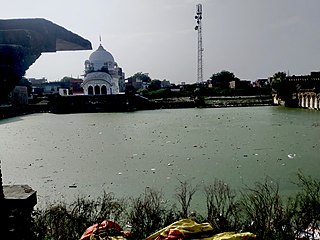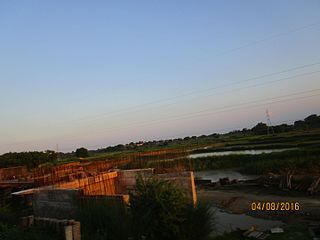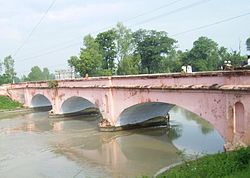
The Ganges is a trans-boundary river of Asia which flows through India and Bangladesh. The 2,525 km (1,569 mi) river rises in the western Himalayas in the Indian state of Uttarakhand. It flows south and east through the Gangetic plain of North India, receiving the right-bank tributary, the Yamuna, which also rises in the western Indian Himalayas, and several left-bank tributaries from Nepal that account for the bulk of its flow. In West Bengal state, India, a feeder canal taking off from its right bank diverts 50% of its flow southwards, artificially connecting it to the Hooghly River. The Ganges continues into Bangladesh, its name changing to the Padma. It is then joined by the Jamuna, the lower stream of the Brahmaputra, and eventually the Meghna, forming the major estuary of the Ganges Delta, and emptying into the Bay of Bengal. The Ganges–Brahmaputra–Meghna system is the second-largest river on earth by discharge.

Haridwar is a city and municipal corporation in the Haridwar district of Uttarakhand, India. With a population of 228,832 in 2011, it is the second-largest city in the state and the largest in the district.

Indian Institute of Technology Roorkee is a technical university located in Roorkee, Uttarakhand, India. It is the second oldest engineering institution in India, and was founded as the College of Civil Engineering in North-Western Provinces in 1847 by the Lieutenant-Governor, James Thomason, in order to train officers and surveyors employed in the construction of the Ganges Canal. In 1854 , after the completion of the canal and Thomason's death, it was renamed the Thomason College of Civil Engineering by Proby Cautley, the designer and projector of the canal. It was renamed University of Roorkee in 1949, and again renamed IIT Roorkee in 2001. The institution has 22 academic departments covering Engineering, Applied Sciences, Humanities & Social Sciences and Management programs with an emphasis on scientific and technological education and research.

The Yamuna is the second-largest tributary river of the Ganges by discharge and the longest tributary in India. Originating from the Yamunotri Glacier at a height of about 4,500 m (14,800 ft) on the southwestern slopes of Bandarpunch peaks of the Lower Himalaya in Uttarakhand, it travels 1,376 kilometres (855 mi) and has a drainage system of 366,223 square kilometres (141,399 sq mi), 40.2% of the entire Ganges Basin. It merges with the Ganges at Triveni Sangam, Prayagraj, which is a site of the Kumbh Mela, a Hindu festival held every 12 years.

The United Provinces of Agra and Oudh was a province of India under the British Raj, which existed from 22 March 1902 to 1937; the official name was shortened by the Government of India Act 1935 to United Provinces (UP), by which the province had been commonly known, and by which name it was also a province of independent India until 1950.

Doab is a term used in South Asia for the tract of land lying between two confluent rivers. It is similar to an interfluve. In the Oxford Hindi-English Dictionary, R. S. McGregor defines it as from Persian do-āb "a region lying between and reaching to the confluence of two rivers."

Roorkee (Rūṛkī) is a city and a municipal corporation in the Haridwar district of the state of Uttarakhand, India. It is 31 km (19 mi) from Haridwar city, the district headquarter. It was a part of Landhaura Princely State of Panwar Gurjar's till 1824 when the British occupied it by defeating first freedom fighter Vijay Singh Gujjar. It is spread over a flat terrain under Sivalik Hills of Himalayas. The city is developed on the banks of Ganges Canal, its dominant feature, which flows from north–south through middle of the city. Roorkee is home to Asia's first engineering college Indian Institute of Technology Roorkee, formerly known as Thomson College of Civil Engineering. Roorkee is also known for the Roorkee Cantonment, one of the country's oldest military establishments and the headquarters of Bengal Engineer Group since 1853. A freight train ran in between Roorkee and Piran Kaliyar on 22 December 1851, this was two years before first passenger trains were started between Bombay and Thana in 1853 and 14 years after first freight trains ran in Chennai in 1837.

Sir Proby Thomas Cautley, KCB, English engineer and palaeontologist, born in Stratford St Mary, Suffolk, is best known for conceiving and supervising the construction of the Ganges canal during East India Company rule in India. The canal stretches some 350 miles between its headworks at Haridwar and, after bifurcation near Aligarh, its confluences with the Ganges river mainstem in Kanpur and the Yamuna river in Etawah. At the time of completion, it had the greatest discharge of any irrigation canal in the world.

Haridwar district also spelled as Hardwar is part of Uttarakhand, India.It lies in doab region where people speak khari boli. It is headquartered at Haridwar which is also its largest city. The district is ringed by the districts Dehradun in the north and east, Pauri Garhwal in the east and the Uttar Pradesh districts of Muzaffarnagar and Bijnor in the south and Saharanpur in the west.
Behat is an ancient town, near Saharanpur and nagar panchayat of Saharanpur district on the northernmost tip of northwestern Uttar Pradesh, India. It is located on NH-709B on the banks of Eastern Yamuna Canal, about 30 km north of Saharanpur, 190 km from New Delhi, and 77 km from Haridwar. It has an average elevation of 345 m above sea level. It is famous for the production of fruits such as mangoes, guavas, moorhas, brass bells, and wrought iron handicrafts. It is home to the Mata Shakumbari Devi Temple.
Bahadrabad is an intermediate Village Panchayat in the Haridwar district of Uttarakhand, India. It is one of the six development blocks in Haridwar district under which many developed villages come, including Atmalpur Bongla, Rohalki-Kishanpur, Alipur, Garhmeerpur, Khedli, Sitapur.
Bhognipur or Bhoganipur is a town in Kanpur Dehat district in the Indian state of Uttar Pradesh. It is the headquarters of the Tehsil of the same name and consists of the Amraudha and Malasa Development Blocks.

Kanpur Dehat district is a district in Uttar Pradesh state in northern India. The administrative headquarters of the district are at Mati-Akbarpur. This district is part of Kanpur division. Kanpur was formerly spelled Cawnpore.
Upper Ganges Canal Expressway, also known as Hindon Expressway, is a planned eight-lane 150-kilometre-long (93 mi) expressway. It is planned to stretch from Bulandshahr, Uttar Pradesh to Haridwar, Uttarakhand through Muzaffarnagar and Roorkee, in India.

The Uttar Pradesh Expressways Industrial Development Authority (UPEIDA) is an authority set up in 2007 by the Government of Uttar Pradesh to develop expressway projects in the state. The headquarters of UPEIDA is located at Paryatan Bhawan in Gomti Nagar, Lucknow.

The Bhimgoda Barrage, also referred to as the Bhimgoda Weir or Bhimgoda Head Works, is a barrage on the Ganges River at Har ki Pauri near Haridwar in Haridwar district, Uttarakhand, India. Built as the headworks of the Upper Ganges Canal, an initial barrage was completed by 1854 and replaced twice; the final one completed in 1983. The primary purpose for the barrage is irrigation but it also serves to provide water for hydroelectric power production and control floods. The area behind the barrage is known as the Neel Dhara Bird Sanctuary and is a popular destination for various waterbirds and tourists.

Irrigation in India includes a network of major and minor canals from Indian rivers, groundwater well based systems, tanks, and other rainwater harvesting projects for agricultural activities. Of these groundwater system is the largest. In 2013–14, only about 36.7% of total agricultural land in India was reliably irrigated, and remaining 2/3 cultivated land in India is dependent on monsoons. 65% of the irrigation in India is from groundwater. Currently about 51% of the agricultural area cultivating food grains is covered by irrigation. The rest of the area is dependent on rainfall which is most of the times unreliable and unpredictable.

Sengar River is a tributary of the river Yamuna in the northern Indian state of Uttar Pradesh.
Bhangeri is a village in Roorkee tehsil in the green terai region of Sivalik Hills of the Himalayas. Its official name is Bhangeri Mahavatpur. Gradually, villagers gave up their traditional profession of training elephants. High-quality cannabis (Bhang) plants grow naturally in the uncultivated lands around the village. Residents started calling the village Bhangeri, or "the place where bhang grows." The name stuck, and the village came to be known popularly as Bhangeri and officially as Bhangeri Mahavatpur.
Madhopur Headworks is a barrage on the Ravi River in Madhopur, just 14 km from Pathankot city in Pathankot district in the Indian state of Punjab. It is located on the border with Jammu and Kashmir. The Upper Bari Doab Canal (UBDC) off-taking from Madhopur irrigates agricultural lands in Punjab and provides water to the cities of Pathankot, Gurdaspur, Batala and Amritsar.























